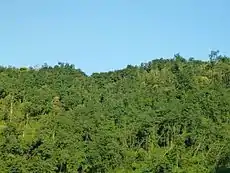Criorhina floccosa
Criorhina floccosa, is a species of hoverfly. It is found in many parts of the Palearctic including Europe.[3]
| Criorhina floccosa | |
|---|---|
 | |
| male | |
 | |
| female | |
| Scientific classification | |
| Domain: | Eukaryota |
| Kingdom: | Animalia |
| Phylum: | Arthropoda |
| Class: | Insecta |
| Order: | Diptera |
| Family: | Syrphidae |
| Subfamily: | Eristalinae |
| Tribe: | Milesiini |
| Subtribe: | Criorhinina |
| Genus: | Criorhina |
| Species: | C. floccosa |
| Binomial name | |
| Criorhina floccosa | |
| Synonyms | |
The larvae of C. floccosa are associated with rotting deciduous wood. Adults are usually found in woodland with overmature trees and are seen visiting flowers to feed.[4]
Description
External images
For terms see Morphology of Diptera
A large, broad, bumblebee mimic (wing length 10–13 mm.), densely yellow, fox red or yellow and black pilose. Tergite 2 with distinct side tufts of long yellow hairs. Tergites 3 and 4 with short, dense reddish or tawny pile and dust, not obscuring the ground-colour. Tibia 1 and 2 with pale, adpressed, short hairs.
[5]
[6]
[7][8] The larva is illustrated by Rotheray (1993) [9]
Distribution
Palaearctic. South Sweden and Denmark South to the Pyrenees from Ireland eastwards to European Russia as far as the Caucasus[10][11]

Biology
Habitat: Fagus and Quercus ancient woodland with over-mature and senescent trees.[12] Arboreal, but descends to visit flowers of white umbellifers, Cornus sanguinea, Crataegus, Photinia, Prunus spinosa, Ribes alpina, Rubus idaeus, Sorbus aucuparia, Sorbus aria.[13] The flight period is from the beginning of April to the beginning of July.
See also
Other bumblebee mimics are Mallota, Arctophila, Pocota and Brachypalpus. Criorhina differ from these genera in the form of the antennae.
References
- Meigen, Johann Wilhelm (1822). Systematische Beschreibung der bekannten europäische n zweiflugeligen Insekten. Hamm: Dritter Theil. Schulz-Wundermann. pp. x, 416, pls. 22–32. Retrieved 14 April 2019.
- Fallen, C.F. (1826). Supplementum Dipterorum Sveciae. Lundae [= Lund].
- Stubbs, Alan E.; Falk, Steven J (1983). British Hoverflies: An Illustrated Identification Guide (2nd ed.). London: British Entomological and Natural History Society. pp. 253, xvpp. ISBN 1-899935-03-7.
- Ball, S.G.; Morris, R.K.A. (2000). Provisional atlas of British hoverflies (Diptera, Syrphidae). Monks Wood, UK: Biological Records Centre. pp. 167 pages. ISBN 1-870393-54-6.
- Van Veen, M. (2004) Hoverflies of Northwest Europe: identification keys to the Syrphidae. 256pp. KNNV Publishing, Utrecht.addendum
- Van der Goot,V.S. (1981) De zweefvliegen van Noordwest - Europa en Europees Rusland, in het bijzonder van de Benelux. KNNV, Uitgave no.32: 275pp. Amsterdam.
- Bei-Bienko, G.Y. & Steyskal, G.C. (1988) Keys to the Insects of the European Part of the USSR, Volume V: Diptera and Siphonaptera, Part I. Amerind Publishing Co., New Delhi. ISBN 81-205-0080-6.
- Coe, R.L. (1953) Diptera: Syrphidae. Handbks.ident.Br.insects, 10(1): 1-98. R.ent.Soc.London. pdf
- Rotheray G., 1993 Colour Guide to Hoverfly Larvae Diptera, Syrphidae in Britain and Europe Dipterists Forum pdf Archived 2019-04-03 at the Wayback Machine
- Fauna Europaea
- Peck, L.V. (1988) Syrphidae. In: Soos, A. & Papp, L. (eds.) Catalogue of Palaearctic Diptera, 8: 11-230. Akad.Kiado, Budapest.
- Speight, M.C.D. (2011). "Species accounts of European Syrphidae (Diptera)" (PDF). Syrph the Net, the database of European Syrphidae. 65: 285pp.
- de Buck, N. (1990) Bloembezoek en bestuivingsecologie van Zweefvliegen (Diptera, Syrphidae) in het bijzonder voor België. Doc.Trav. IRSNB, no.60, 1-167.